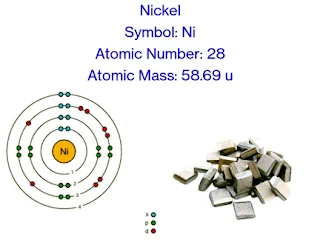Unveiling the Shining Alloy: A Closer Look at Nickel
Nickel:
Nickel, with its symbol Ni and atomic number 28, is a versatile metal that plays a crucial role in various industries. From its chemical properties to its economic significance, let's delve into the world of nickel.
Chemical and Physical Properties:
Atomic Mass: Nickel has an atomic mass of approximately 58.69 atomic mass units.
Electron Configuration and Valency: Its electron configuration is [Ar] 3d8 4s2 or 1s², 2s², 2p⁶, 3s², 3p⁶, 4s², 3d⁸, and it typically exhibits a valency of +2.
Oxidation States: Nickel commonly displays oxidation states of +2 and +3, with +2 being the more prevalent form.
Reactivity and Reactions:
Nickel exhibits moderate reactivity, tarnishing slowly in air.
It forms alloys readily, such as the popular nickel-copper alloy known as cupronickel.
Nickel does not react with water, but it can dissolve in dilute acids.
Uses and Applications:
1. Stainless Steel Production: Nickel is a key component in stainless steel, contributing corrosion resistance and strength to the alloy.
2. Batteries: Nickel is widely used in rechargeable batteries, such as nickel-cadmium (Ni-Cd) and nickel-metal hydride (Ni-MH) batteries.
3. Electronics: The metal is crucial in electronic devices, including transistors, sensors, and connectors.
4. Coinage: Nickel has historical ties to coinage, often used in the alloy known as cupronickel for coins.
5. Chemical Catalysts: It serves as a catalyst in various chemical reactions due to its unique properties.
Occurrence and Production:
Nickel is primarily found in sulfide ores and lateritic nickel deposits.
The leading nickel-producing countries include Indonesia, the Philippines, Russia, Canada, and Australia.
LME Nickel and Price Trends:
The London Metal Exchange (LME) is a crucial platform for nickel trading.
Nickel prices can be influenced by various factors, including demand from stainless steel production, geopolitical events, and global economic conditions.
Interesting Facts:
1. Allergic Reactions: Some people may be allergic to nickel, leading to skin rashes when in direct contact with nickel-containing items.
2. Unique Magnetic Properties: Nickel is ferromagnetic at room temperature, making it a valuable material in certain applications.
3. Space Exploration: Nickel alloys are used in spacecraft due to their resistance to high temperatures and corrosion.
Conclusion:
Nickel's significance in various industries, from stainless steel production to electronics, highlights its versatility. As we navigate through technological advancements and explore new frontiers, nickel continues to shine as a fundamental element in our modern world. Whether it's in the stainless steel of our appliances or the batteries powering our devices, nickel's presence is a testament to its enduring role in shaping our lives.
Also Read:
Neon | Descriptions, Chemical and Physical Properties, Uses & Facts
Nitrogen | Descriptions, Chemical and Physical Properties, Uses & Facts
Beryllium | Descriptions, Chemical and Physical Properties, Uses & Facts
Hydrogen | Difference between Blue and Green Hydrogen | Hydrogen Fuel









0 Comments